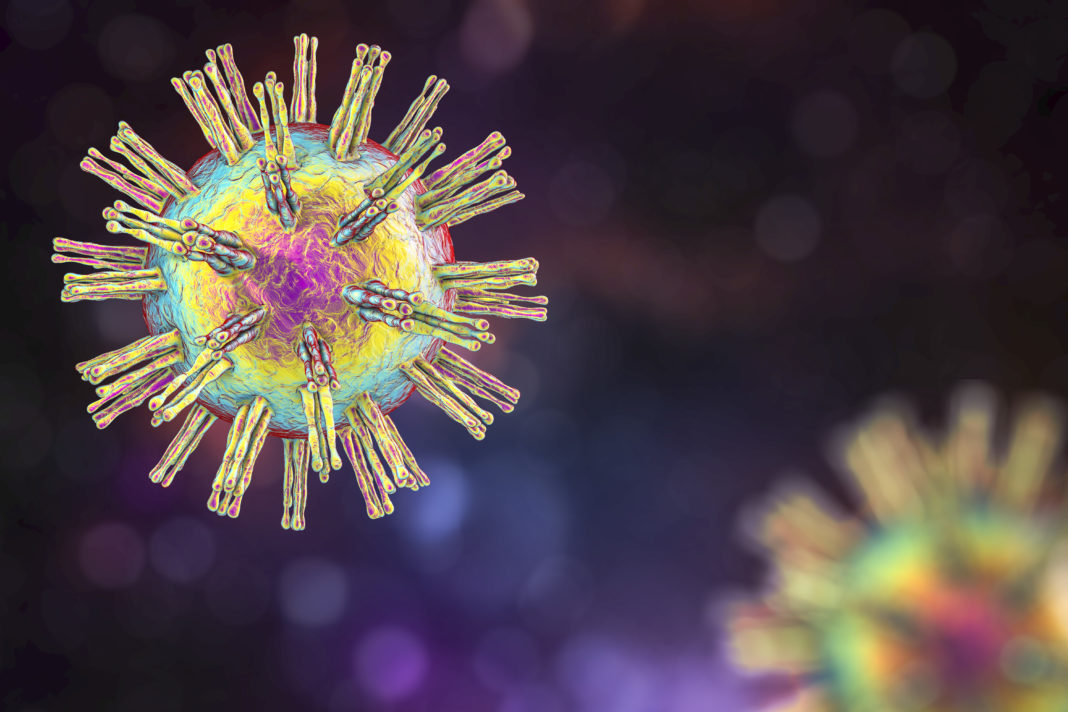More than half of U.S. adults are carriers of herpes simplex virus type 1 (HSV-1), a virus that hibernates in the peripheral nervous system and can’t be eradicated. A Northwestern University study has now discovered that HSV-1’s strategy for infecting the nervous system involves hijacking a cellular protein from the epithelial cells that it initially infects, and then using this protein to infect and reach the nuclei of peripheral nervous system cells. The researchers suggest the findings could help direct the future development of long-needed vaccines for both HSV-1 and its close relative, HSV-2.
“This is the first discovery of any virus repurposing a cellular protein and using it to drive subsequent rounds of infection,” said Caitlin Pegg, a graduate student in the laboratory of research lead Greg Smith, PhD, professor of microbiology and immunology at Northwestern University Feinberg School of Medicine.
“We are excited to further uncover the molecular mechanisms that these viruses have evolved that make them arguably the most successful pathogens known to science,” Smith added. First author Pegg, Smith, and colleagues reported on their findings in Nature, in a paper titled, “Herpesviruses assimilate kinesin to produce motorized viral particles.”
Although the alphaherpesvirus HSV-1 can’t be eradicated in people who have been infected, some individuals who carry the virus will never even experience so much as a cold sore. But for others, HSV-1 infection can cause blindness or life-threatening encephalitis. “Recurrent infections arise sporadically from the peripheral nervous system throughout the life of the host, and invasion of the central nervous system may occur, with severe outcomes,” the authors wrote. “We desperately need a vaccine to prevent herpes from invading the nervous system,” said Smith. There is also increasing evidence that HSV-1 contributes to dementia.
HSV-2, which is more commonly transmitted via sexual contact, can also be passed from a mother to newborn during the birthing process, as neonatal herpes, appearing as lesions all over the body of the infant. And while most babies recover, in the worst cases, HSV-2 infection can cause brain damage or disseminate through all the organs and be lethal.
HSV-1 and related viruses directly recruit cellular motors for transport along microtubules in nerve axons, but how the motors are manipulated to deliver the virus to neuronal nuclei isn’t understood. “The virus needs to inject its genetic code into the nucleus, so it can start making more herpes viruses,” Smith explained. “It reprograms the cell to become a virus factory. The big question is how does it get to the nucleus of a neuron?”
Like many viruses, herpes hops onto the cell’s microtubules and uses protein engines called dynein and kinesin to move along. The newly reported studies by the Smith lab, which used HSV-1 and another alphaherpesvirus, pseudorabies virus (PRV), discovered that HSV-1 effectively kidnaps a kinesin protein from the epithelial cells it first infects, and then turns this protein into a defector to help ferry the virus into the nucleus of a neuron in the peripheral nervous system. Discovery of this “assimilation” mechanism may have wide-ranging implications for many viruses, including HIV and SARS-CoV-2, Smith said. “By learning how the virus is achieving this incredible feat to get into our nervous system, we can now think about how to take away that ability. You can stop it from assimilating kinesin, you would have a virus that couldn’t infect the nervous system. And then you have a candidate for a preventive vaccine.” As the authors further pointed out, “The repurposing of a cellular protein, in this instance a microtubule motor, as an essential virion structural component is unprecedented, to our knowledge …”
Explaining the process further, the researchers liken the cell as a rail yard, in which all tracks lead to the centrosome hub. The proteins dynein and kinesin effectively represent two engines. One travels toward the hub, and the other leads away from it.
When a more typical virus, such as influenza, infects mucosal epithelial cells that line the nose and mouth it grabs both engines and moves back and forth on the microtubule tracts until it eventually arrives at the nucleus more or less by chance. Overall, traveling to the nucleus via the centrosome is a relatively short commute.
But traveling down nerves is the equivalent of a cross-country journey. Herpes jumps on the dynein engine for this trip, but it also makes sure kinesin engines do not take it back the way it came. “It’s a long way to go,” Smith said. “It probably takes eight hours for it to travel from the end of the neuron to the hub.”
But the dynein engine can’t take it any further than the hub. And HSV-1 needs to reach the nucleus. That’s when it recruits the kinesin engine that it kidnapped from the mucosal epithelial cells. The assimilated kinesin then ferries the virus right to the nucleus. “HSV-1 assimilated kinesin-1 by capturing the protein complex from epithelial cells, carrying it to neurons (as well as other cell types) and repurposing the motor to deliver the viral particles to nuclei following axonal transport to the centrosome,” the authors stated.
The findings explain what they described as “a critical component of the alphaherpesvirus neuroinvasive mechanism,” and demonstrate that the viruses assimilate a cellular protein as an essential proviral structural component. “This principle of viral assimilation may prove relevant to other virus families and offers new strategies to combat infection,” the team concluded. ” … the dependence of HSV-1 and PRV on assimilated kinesin indicates that the abundant kinesin motors encountered upon entering a cell are insufficient to effectively traffic these viruses to nuclei. This initial description of assimilation raises the questions of whether cellular proteins other than kinesin motors are targeted for assimilation, and whether the process extends beyond the alphaherpesviruses.”






